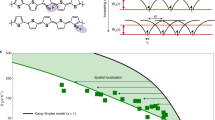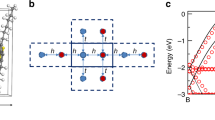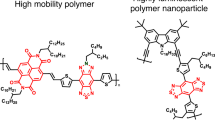Abstract
Electron transport in semiconducting polymers is usually inferior to hole transport, which is ascribed to charge trapping on isolated defect sites situated within the energy bandgap. However, a general understanding of the origin of these omnipresent charge traps, as well as their energetic position, distribution and concentration, is lacking. Here we investigate electron transport in a wide range of semiconducting polymers by current–voltage measurements of single-carrier devices. We observe for this materials class that electron transport is limited by traps that exhibit a Gaussian energy distribution in the bandgap. Remarkably, the electron-trap distribution is identical for all polymers considered: the number of traps amounts to 3 × 1023 traps per m3 centred at an energy of ~3.6 eV below the vacuum level, with a typical distribution width of ~0.1 eV. This indicates that the electron traps have a common origin that, we suggest, is most likely related to hydrated oxygen complexes. A consequence of this finding is that the trap-limited electron current can be predicted for any polymer.
This is a preview of subscription content, access via your institution
Access options
Subscribe to this journal
Receive 12 print issues and online access
$259.00 per year
only $21.58 per issue
Buy this article
- Purchase on Springer Link
- Instant access to full article PDF
Prices may be subject to local taxes which are calculated during checkout





Similar content being viewed by others
References
Friend, R. H. et al. Electroluminescence in conjugated polymers. Nature 397, 121–128 (1999).
Brabec, C. J., Sariciftci, N. S. & Hummelen, J. C. Plastic solar cells. Adv. Funct. Mater. 11, 15–26 (2001).
Blom, P. W. M. & Vissenberg, M. C. J. M. Charge transport in poly(p-phenylene vinylene) light-emitting diodes. Mater. Sci. Eng.: R 27, 53–94 (2000).
Tanase, C., Meijer, E. J., Blom, P. W. M. & de Leeuw, D. M. Unification of the hole transport in polymeric field-effect transistors and light-emitting diodes. Phys. Rev. Lett. 91, 216601 (2003).
Pasveer, W. F. et al. Unified description of charge-carrier mobilities in disordered semiconducting polymers. Phys. Rev. Lett. 94, 206601 (2005).
Brédas, J. L., Calbert, J. P., Da Silva Filho, D. A. & Cornil, J. Organic semiconductors: A theoretical characterization of the basic parameters governing charge transport. Proc. Natl Acad. Sci. USA 99, 5804–5809 (2002).
Blom, P. W. M., de Jong, M. J. M & Vleggaar, J. J. M. Electron and hole transport in poly(p-phenylene vinylene) devices. Appl. Phys. Lett. 68, 3308–3310 (1996).
Mandoc, M. M., de Boer, B., Paasch, G. & Blom, P. W. M. Trap-limited electron transport in disordered semiconducting polymers. Phys. Rev. B 75, 193202 (2007).
Graupner, W., Leditzky, G., Leising, G. & Scherf, U. Shallow and deep traps in conjugated polymers of high intrachain order. Phys. Rev. B 54, 7610–7613 (1996).
Meier, M., Karg, S., Zuleeg, K., Brütting, W. & Schwoerer, M. Determination of trapping parameters in poly(p-phenylenevinylene) light-emitting devices using thermally stimulated currents. J. Appl. Phys. 84, 87–92 (1998).
Kuik, M. et al. Determination of the trap-assisted recombination strength in polymer light emitting diodes. Appl. Phys. Lett. 98, 093301 (2011).
Wetzelaer, G. A. H., Kuik, M., Nicolai, H. T. & Blom, P. W. M. Trap-assisted and Langevin-type recombination in organic light-emitting diodes. Phys. Rev. B 83, 165204 (2011).
Kuik, M., Koster, L. J. A., Wetzelaer, G. A. H. & Blom, P. W. M. Trap-assisted recombination in disordered organic semiconductors. Phys. Rev. Lett. 107, 256805 (2011).
Nicolai, H. T., Mandoc, M. M. & Blom, P. W. M. Electron traps in semiconducting polymers: Exponential versus Gaussian trap distribution. Phys. Rev. B 83, 195204 (2011).
Zhang, Y., de Boer, B. & Blom, P. W. M. Trap-free electron transport in poly(p -phenylene vinylene) by deactivation of traps with n-type doping. Phys. Rev. B 81, 085201 (2010).
Chua, L-L. et al. General observation of n-type field-effect behaviour in organic semiconductors. Nature 434, 194–199 (2005).
Nicolai, H. T. et al. Space-charge-limited hole current in poly(9,9-dioctylfluorene) diodes. Appl. Phys. Lett. 96, 172107 (2010).
Tanase, C., Blom, P. W. M., de Leeuw, D. M. & Meijer, E. J. Charge carrier density dependence of the hole mobility in poly(p-phenylene vinylene). Phys. Status Solidi A 201, 1236–1245 (2004).
Kuik, M. et al. Optical detection of deep electron traps in poly(p-phenylene vinylene) light-emitting diodes. Appl. Phys. Lett. 99, 183305 (2011).
Fung, M. K. et al. Role of ytterbium and ytterbium/cesium fluoride on the chemistry of poly(9,9-dioctylfluorene-co-benzothiadiazole) as investigated by photoemission spectroscopy. J. Appl. Phys. 94, 2686–2694 (2003).
Gwinner, M. C. et al. Solution-processed zinc oxide as high-performance air-stable electron injector in organic ambipolar light-emitting field-effect transistors. Adv. Funct. Mater. 20, 3457–3465 (2010).
Mühlbacher, D. et al. High photovoltaic performance of a low-bandgap polymer. Adv. Mater. 18, 2884–2889 (2006).
Aygül, U. et al. Electronic properties of interfaces between PCPDTBT and prototypical electrodes studied by photoemission spectroscopy. ChemPhysChem 12, 2345–2351 (2011).
Al-Ibrahim, M. et al. Phenylene-ethynylene/phenylene-vinylene hybrid polymers: Optical and electrochemical characterization, comparison with poly[2-methoxy-5-(3′,7′-dimethyloctyloxy)-1,4-phenylene vinylene] and application in flexible polymer solar cells. Thin Solid Films 474, 201–210 (2005).
Guan, Z-L. et al. Direct determination of the electronic structure of the poly(3-hexylthiophene):phenyl-[6,6]-C61 butyric acid methyl ester blend. Org. Electron. 11, 1779–1785 (2010).
Thakur, A. K., Mukherjee, A. K., Preethichandra, D. M. G., Takashima, W. & Kaneto, K. Charge injection mechanism across the Au-poly(3-hexylthiophene-2,5-diyl) interface. J. Appl. Phys. 101, 104508 (2007).
Lee, J. U., Kim, Y. D., Jo, J. W., Kim, J. P. & Jo, W. H. Efficiency enhancement of P3HT/PCBM bulk heterojunction solar cells by attaching zinc phthalocyanine to the chain-end of P3HT. J. Mater. Chem. 21, 17209–17218.
Sirringhaus, H. et al. Two-dimensional charge transport in self-organized, high-mobility conjugated polymers. Nature 401, 685–688 (1999).
Tseng, H-E., Peng, K-Y. & Chen, S-A. Molecular oxygen and moisture as traps in poly[2-methoxy-5-(2′-ethylhexyloxy)-1,4-phenylene vinylene]: Locations and detrapping by chain relaxation. Appl. Phys. Lett. 82, 4086–4088 (2003).
Kažukauskas, V. Investigation of carrier transport and trapping by oxygen-related defects in MEH–PPV diodes. Semicond. Sci. Technol. 19, 1373–1380 (2004).
De Leeuw, D. M., Simenon, M. M. J., Brown, A. R. & Einerhand, R. E. F. Stability of n-type doped conducting polymers and consequences for polymeric microelectronic devices. Synth. Met. 87, 53–59 (1997).
Anthopoulos, T. D., Anyfantis, G. C., Papavassiliou, G. C. & de Leeuw, D. M. Air-stable ambipolar organic transistors. Appl. Phys. Lett. 90, 122105 (2007).
Simmons, J. G. & Taylor, G. W. High-field isothermal currents and thermally stimulated currents in insulators having discrete trapping levels. Phys. Rev. B 5, 1619–1629 (1972).
Lang, D. V. Deep-level transient spectroscopy: A new method to characterize traps in semiconductors. J. Appl. Phys. 45, 3023–3032 (1974).
Werner, A. G., Blochwitz, J., Pfeiffer, M. & Leo, K. Field dependence of thermally stimulated currents in Alq3 . J. Appl. Phys. 90, 123–125 (2001).
Steiger, J., Schmechel, R. & von Seggern, H. Energetic trap distributions in organic semiconductors. Synth. Met. 129, 1–7 (2002).
Xing, K. et al. The interaction of poly (p-phenylenevinylene) with air. Adv. Mater. 8, 971–974 (1996).
Sutherland, D. G. J. et al. Photo-oxidation of electroluminescent polymers studied by core-level photoabsorption spectroscopy. Appl. Phys. Lett. 68, 2046–2048 (1996).
Xing, K. Z. et al. Photo-oxidation of poly(p-phenylenevinylene). Adv. Mater. 9, 1027–1031 (2004).
Zhuo, J. et al. Direct spectroscopic evidence for a photodoping mechanism in polythiophene and poly(bithiophene-alt-thienothiophene) organic semiconductor thin films involving oxygen and sorbed moisture. Adv. Mater. 21, 4747–4752 (2009).
Haynes, W. M. CRC Handbook of Chemistry and Physics (CRC, 2011).
Bell, A. J. & Wright, T. G. Structures and binding energies of O2–·H2O and O2·H2O. Phys. Chem. Chem. Phys. 6, 4385–4390 (2004).
Gomes, J. A. G. et al. Experimental and theoretical study of the atmospherically important O2H2O complex. Spectrochim. Acta A 61, 3082–3086 (2005).
Grimme, S. Semiempirical GGA-type density functional constructed with a long-range dispersion correction. J. Comput. Chem. 27, 1787–1799 (2006).
Klamt, A. & Schüürmann, G. COSMO: A new approach to dielectric screening in solvents with explicit expressions for the screening energy and its gradient. J. Chem. Soc. Perkin Trans. 2, 799–805 (1993).
Andzelm, J., Kölmel, C. & Klamt, A. Incorporation of solvent effects into density functional calculations of molecular energies and geometries. J. Chem. Phys. 103, 9312–9320 (1995).
Barone, V. & Cossi, M. Quantum calculation of molecular energies and energy gradients in solution by a conductor solvent model. J. Phys. Chem. A 102, 1995–2001 (1998).
Cossi, M., Rega, N., Scalmani, G. & Barone, V. Energies, structures, and electronic properties of molecules in solution with the C-PCM solvation model. J. Comput. Chem. 24, 669–681 (2003).
Frisch, M. J. et al. Gaussian 09, Revision A.02 (Gaussian, 2009).
Moet, D. J. D., de Bruyn, P. & Blom, P. W. M. High work function transparent middle electrode for organic tandem solar cells. Appl. Phys. Lett. 96, 153504 (2010).
Acknowledgements
The authors thank M. Lenes, Y. Zhang, M. Mandoc and M. Lu for their contributions to this work and J. Harkema for technical support. The work at the University of Groningen was supported by the European Commission under contract FP7-13708 (AEVIOM). The work at Georgia Tech was supported by the MRSEC Program of the National Science Foundation under Award Number DMR-0819885.
Author information
Authors and Affiliations
Contributions
P.W.M.B. and B.d.B. proposed and supervised the project. H.T.N., M.K. and G.A.H.W. carried out experiments. H.T.N. and M.K. analysed the electron transport data. J.L.B. supervised the quantum-chemical calculations. C.C. and C.R. carried out the quantum-chemical calculations and C.R. analysed the data. H.T.N., C.R. and J.L.B. wrote the manuscript.
Corresponding author
Ethics declarations
Competing interests
The authors declare no competing financial interests.
Supplementary information
Supplementary Information
Supplementary Information (PDF 798 kb)
Rights and permissions
About this article
Cite this article
Nicolai, H., Kuik, M., Wetzelaer, G. et al. Unification of trap-limited electron transport in semiconducting polymers. Nature Mater 11, 882–887 (2012). https://doi.org/10.1038/nmat3384
Received:
Accepted:
Published:
Issue Date:
DOI: https://doi.org/10.1038/nmat3384
This article is cited by
-
Water binding and hygroscopicity in π-conjugated polyelectrolytes
Nature Communications (2023)
-
Elimination of charge-carrier trapping by molecular design
Nature Materials (2023)
-
Large-bandgap organic semiconductors with trap-free charge transport
Nature Materials (2023)
-
Reverse dark current in organic photodetectors and the major role of traps as source of noise
Nature Communications (2021)
-
Direct observation of trap-assisted recombination in organic photovoltaic devices
Nature Communications (2021)



